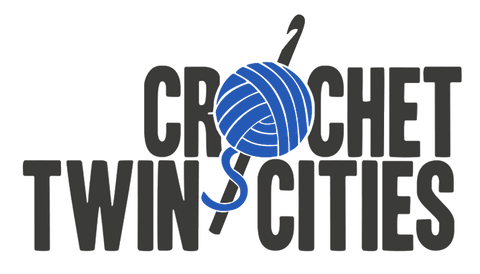 In case you missed it, this picture shows some of our CAL participants from last fall. We did our first CAL in 2014 and had so much fun with it we decided to have another in 2015. We'll be getting started soon so thought it would be a good idea to answer some of the questions we've been asked about this year's CAL.
In case you missed it, this picture shows some of our CAL participants from last fall. We did our first CAL in 2014 and had so much fun with it we decided to have another in 2015. We'll be getting started soon so thought it would be a good idea to answer some of the questions we've been asked about this year's CAL.I've never participated in a CAL before. How does a CAL work?
The basic idea of a "crochet-a-long" project is that a group of people work on the same project together so that they can learn together and help each other. We've heard from a lot of members that they'd like to learn more about garment making so this year's CAL will be a vest.
Why a vest?
We chose a vest for this year's CAL because we want to review techniques we have learned and want to include new techniques such as seaming and blocking of multiple pieces, short rows, and bottom-up construction. A vest provides the perfect opportunity for learning these techniques - it doesn't take quite as much time or yarn as a sweater, but the skills used in construction can serve as "stepping stones" to sweater construction. We selected three patterns as finalists for the CAL, based upon some specific criteria:
- Free or low cost pattern
- Suitable for both advanced beginners and experienced crocheters
- A garment with appeal to variety of fashion styles, ages and body types
- A pattern with multiple sizes with a chart and/or schematic
- A pattern with recommended or substitute yarn readily available
How will we decide which of the three pattern we'll use for the CAL?
This is how the final choice will be determined:
- CTC members will be given a choice of three patterns and the opportunity to vote for which one they like the best; watch for more information in the June newsletter.
- The pattern which receives the highest number of votes will be our CAL 2015 pattern.
- The winning CAL pattern will be announced in the July newsletter.
- Our monthly meetings from August through November will support the CAL.
Pattern support will be available for the 2015 CAL project but if you don't want to work on the CAL pattern and prefer to use a different one, that's OK too, the meeting topics will apply to any crochet projects.
We also will explain some options about how to use the patterns but deviate from the original intent of the designer. For example, two of the patterns are designed for bulky weight yarns (the other for worsted weight) but we know that some members prefer to use lighter weight yarns. Early swatching experiments have shown that doubling the stitch counts and using a different hook size may allow you to achieve gauge so you can still use the pattern. If the pattern is complex, this doesn't work well but these patterns all have simple lines and styling so if that's what you'd like to do, we'll be glad to give you guidance!
Can you explain a little more about how the monthly programs will support the CAL?
We'll be teaching specific topics related to the CAL every month from August through November. In order to benefit the most from the meetings, you'll need to complete specific portions of the vest between meetings. It's probably easiest to explain in a table.
| July 11 Meeting – announce winning pattern; answer brief CAL questions | |
August 8 Meeting – CAL I Prep: ŸTopics covered: What is gauge, why is it important, swatching to make gauge; what to consider when choosing fiber & yarn for your garment; taking correct measurements for best fit |
To be completed on your own for September 12 meeting: Purchase yarn, swatch for gauge, measure at home if desired, read through pattern, begin and finish back of vest & bring to September 12 meeting |
September 12 Meeting - CAL II: ŸBring in finished back of vest; review questions & problems |
To be completed on your own for October 10 meeting: Finish left side of vest and bring to October 10 meeting |
October 10 Meeting – CAL III: ŸFinishing techniques: blocking, seaming, closures – demos & workshop ŸDorset buttons – demo & workshop ŸBring in finished left side & back of vest; review questions & problems |
To be completed on your own for November 14 meeting: Finish right side of vest; block all finished pieces and bring to November 14 meeting |
November 14 Meeting – CAL IV: ŸBring in finished & blocked right & left sides & back of vest; review questions & problems |
To be completed on your own for December 12 meeting: Sew seams; add finishing, closures or embellishments; bring finished vest to December 12 meeting |
| December 12 Meeting: Show and Tell finished vests! | |





